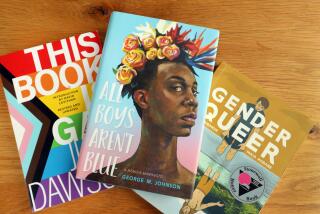Textbooks and Fairy Tales: The Value of Classic Myths
- Share via
Parents in La Puente recoiled recently at what they found in their children’s elementary-school reading books: monsters that cut children’s heads off, pigs that live on body wastes, witches that cast spells. Their objections, spread through a national Christian group called Citizens for Excellence in Education, has resulted in several school districts dropping the nationally used texts.
In targeting the series called “Impressions” and its publisher, Harcourt Brace Jovanovich, the complaining parents seem unaware that what offends them arises from the nature of many literary classics themselves, and that such elements abound in classic literature. The decision to base reading texts on classics--getting away from Dick-and-Jane style readers--was made by the creators of the English-Language Arts Framework of the state of California, not by textbook publishers.
The new texts have been praised by educators for stimulating children’s imaginations, but Citizens for Excellence in Education and other fundamentalist Christian groups have mounted a growing attack on such books as inappropriate for young children, claiming the books attack values that parents try to inculcate in the home.
California-approved school texts are now required to draw selections from literary classics. Such classics have retained their popularity over time and are valued by educators for richness of language, appeal to universal feelings and needs and a “capacity to move the human spirit in any age,” as the state guidelines put it.
But a decision to choose classics as sources of reading material is a decision to accept elements that would not be acceptable in material written in 1990 for today’s educational market. Any reading series adopted in California, therefore, is likely to contain some such elements.
A story that has been around long enough to become classic has necessarily originated at times when different values dominated--some of which are incompatible with those embraced by today’s educational system. Therefore publishers who would write textbooks for the state of California face contradictory mandates. Any original material they write must be free not only of gruesome elements, but of sexism, racism and ageism.
Text material must deal sensitively with disabilities and deformities. Yet textbooks are required to include classics written in a setting where racism and sexual stereotyping are a fact of life; good parents and teachers beat children; elderly or deformed characters are often cast as villains; witches cast evil spells, to be countered by benevolent spells, and a happy tale ends with the cruel and unusual punishment of the guilty.
The elements probably most at odds with today’s values are to be found in fairy tales, traditionally read to young children.
“I would suggest that parents who are concerned about these stories take a look at the Brothers Grimm,” said Thomas Williamson, director of the school textbook division of Harcourt Brace Jovanovich.
The Brothers Grimm--Jakob and Wilhelm, 19th-Century German philologists--created early written versions of the oral tales from which many of today’s popular fairy tales are derived.
Let’s look at the Grimm fairy tales, which children have loved for years--they offer magic and enchantment, triumphs of good over evil, wishes fulfilled under impossible odds. They are tales in which the small, young or weak can vanquish a monstrous or powerful villain, giving children hope. Long before they can evaluate more complex issues, children can appreciate the stark contrast of absolutes: good versus evil, greed versus generosity, industry versus laziness, beauty versus ugliness, cleverness versus stupidity.
On the other hand, Grimm’s and other fairy tales embody many elements that would seem grotesque or perverted even in today’s adult literature. Characters are threatened or devoured by cannibals or human-eating animals and monsters. In the “Robber Bridegroom,” for example, a betrothed maiden discovers that her intended plans to cook and eat her. Hansel is fattened up by the witch and checked daily for weight gain. In early versions of “Little Red Riding Hood,” the heroine is eaten alive as a fitting punishment for her disobedience. In the later Grimm version, she is unappetizingly rescued through an incision in the wolf’s belly, which is subsequently filled with rocks.
The wolf’s punishment is mild compared with that inflicted on many fairy-tale villains. Children demand justice in a story, but justice hardly requires the brutal, inhuman penalties imposed on villains in Grimm’s fairy tales. In “The Goose Girl,” for example, a treacherous maid is “put stark naked into a barrel stuck with nails, and dragged along by two white horses . . . until dead.” In Grimm’s version of “Snow White,” the stepmother is forced to dance in red-hot iron shoes until she dies. In the Grimm version of Cinderella, the stepsisters’ eyes are pecked out by doves--this after they have mutilated their feet in attempts to fit the glass slipper. In “The Pink,” a villain is forced to eat live coals and is then torn into quarters.
Hans Christian Andersen’s fairy tales also contain material that seems sick by today’s standards. In “The Wild Swans,” for example, witches dance naked in the cemetery, dig up dead bodies and eat them. In “The Rose Elf,” a young girl visits her decapitated lover’s grave, digs up his body, retrieves his head, kisses it, takes it home with her and buries it in a flowerpot.
Karen Stone, El Segundo children’s librarian and instructor of literature for adolescents and children at Loyola Marymount University, points out that ancient tales were not originally created for children. “The concept of childhood as we see it is a recent invention--children were once viewed as small adults. They were dressed as adults, educated as adults and worked with adults. Issues in these tales were addressed to adults and children alike.”
In other words, cautionary tales required penalties more significant than being grounded or standing in the corner. Many traditional tales were written to influence the behavior of the audience, and storytellers who would discourage given behavior were challenged to devise deterrents more severe than the hardships and brutal conditions of the historical period.
Not that the behavior rewarded in fairy tales is always exemplary. For example, the “villain” who tears himself in two at the end of “Rumpelstiltskin” is the only character who has told the truth, kept his word and showed compassion. The miller who lies about his daughter, a wife who deceives her husband and a husband who threatens to kill his wife live happily ever after.
Disney versions of fairy tales omit the most gruesome elements. Snow White’s stepmother does not eat the heart she believes to be Snow White’s. Commercial producers are free to adapt these tales at will. The Disney versions of “The Little Mermaid” and “Peter Pan,” for example, depart radically from the story lines of the original classics. Textbook publishers, however, can be penalized for taking such liberties. In many districts, adoption committees rate programs by a system that penalizes them for any editing, abridgement or adaptation of a classic, regardless of the reason.
Publishers can choose from many classic versions of fairy tales, and they choose versions containing the least violence and morbidity. However, they cannot get around the fact that these tales themselves came from times and cultures whose values clashed with our own. Many elements considered objectionable today are inherent in such tales. Can publishers be blamed for that?
Apart from violence, the sexism that pervades fairy tales could never be smuggled past adoption committees if it were written today. In many fairy tales, the heroine is valued primarily as a sexual prize. She need only be young and beautiful to attract countless suitors, often despite appalling behavior and character traits. For example, in Andersen’s “The Traveling Companions,” Hans tours the garden of the princess and finds it decorated by the bones and skulls of the imprudent suitors who have courted her. She had agreed to marry any man who could guess her thoughts, but the penalty for error was a cruel death. Nevertheless, Hans falls in love at first sight.
Fairy tales and other classics are well-crafted works of literature with enduring appeal. As such, they are worth teaching. It behooves parents and teachers, however, to discuss classics in light of the way values have changed.
Parents also need to understand that in order to influence textbook content, they must make their concerns known years before textbooks are purchased. To give one example: The question of evolution versus creation, which came to the fore in California last year during debate over science textbooks, pertains to a science “framework” for schools that will be implemented in 1994.
More to Read
Sign up for our Book Club newsletter
Get the latest news, events and more from the Los Angeles Times Book Club, and help us get L.A. reading and talking.
You may occasionally receive promotional content from the Los Angeles Times.










